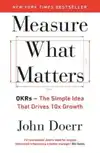Measure What Matters
Table of contents
- 👥 Who Should Read It?
- 💪 How the Book Changed Me
- 📢 My Top 3 Quotes
- 🎯 Bullet Summary
- 🛍 Get it here
- 📕 Full Summary
- Part One: OKRs in Action
- Google, Meet OKRs
- The Father of OKRs
- Operation Crush: An Intel Story
- Superpower 1: Focus and Commit to Priorities
- Superpower 2: Align and Connect for Teamwork
- Superpower 3: Track for Accountability
👥 Who Should Read It?
- Organizations looking for alignment, transparency and a way to drive targeted growth
- Fast-growing organizations looking to scale
- Executives and managers looking for a goal-setting method that really helps
- Individual contributors who want to see their impact on organizational goals
💪 How the Book Changed Me
It made me understand the values and possibilities of OKRs if applied the right way. But I read a lot of further resources on it, especially on how to formulate and leverage outcome-oriented OKRs, which the book is lacking.
📢 My Top 3 Quotes
There are no judgements, only learnings.
Research suggests that making measured headway can be more incentivizing than public recognition, monetary inducements, or even achieving the goal itself.
We do not learn from experience… we learn from reflecting on experience. - John Dewey
🎯 Bullet Summary
- John Doerr teaches us OKRs by extensive storytelling
- More than the half of the book is made of anecdotes and stories, which is obvious if you take a look at the table of contents
- He leverages his explanations with stories from all over the last 40 years
- This also reveals an important insight: The effectiveness of this goal-setting system does not change over time and does not depend much on the kind of organization (with some exceptions like the military or other top-down only organizations)
- While the OKR framework may be universally adoptable, it’s content is not and depends on the organization. The same accounts for the style of direction of the objectives and key results (driven by outputs, inputs, tasks, initiatives, outcomes…), as they should fit other organizational approaches and way of thinkings
- John Doerr describes an output/initiative/action-driven approach to OKRs
- Objectives as well as Key Results are phrased in an action-directed fashion: “Get 10% more revenue to the end of this quarter”
- Personal opinion:
- I prefer outcome-based descriptions for both objectives and key results and to put this action-oriented tasks as initiatives beneath them
- This has a lot of advantages which are represented in a whole lot of literature on outcome-orientation. Most important, outcomes describe a certain behaviour (customer, user, employee, department,organization) that should be implemented and allows a better view of the future, making things “predictable” but above all controlable
🛍 Get it here
📕 Full Summary
Part One: OKRs in Action
- TODO
Google, Meet OKRs
- TODO
The Father of OKRs
Andy Grove
Operation Crush: An Intel Story
Superpower 1: Focus and Commit to Priorities
Focus: The Remind Story
- TODO
Commit: The Nuna Story
- TODO
Superpower 2: Align and Connect for Teamwork
Align: The MyFitnessPal Story
- TODO
Connect: The Intuit Story
Told by Atticus Tysen
We didn’t wanted bureaucratic compliance. We wanted enthusiastic compliance.
- 2,500 objectives per quarter for Intuit’s IT group
- Backed by realtime automated data and routine check-ins
- Around 7 views of line managers OKRs per employee and quarter
Superpower 3: Track for Accountability
- Challenge: Interconnect OKRs in big organizations
- Example: 80,000 employees will produce 320,000 files per year if using MS Word
- The author therefore recommends using an OKR SaaS product
Midlife Tracking
Research suggests that making measured headway can be more incentivizing than public recognition, monetary inducements, or even achieving the goal itself.
If the ladder is not leaning against the right wall, every step we take just gets us to the wrong place fasteer - Stephen Covey
- Track and check-in to OKRs on a regular basis
- Certain actions possible to get yourself on track again (for Objectives as well as for Key Results):
- Continue: Things “on track”
- Update: Things “Need attention”
- Start: Launch new OKR mid-cycle if needed
- Stop: Things “on risk”, may drop them if update not suitable and goal no longer the right one (which is measured). Re-Sync with others (depending on/supporting that OKR) and Reflection needed!
Wrap-up: Rinse and Repeat
Objective Scoring
- 0.0 - 0.3 🔴 Red (We failed to make real progress)
- 0.4 - 0.6 🟡 Yellow (We made progress, but fell short of completion)
- 0.7 - 1.0 🟢 Green (We delivered)
- For non-stretch-goals: Just 1 and 0
Subjective Self-Assessment
Don’t rely on the objective scoring. Even with 100% reached at a certain key result, the outcome could probably not reflecting 100% of the objective. For example, if the goal is to get 10 new customers in a quarter, you may get 5 high-revenue customers or 10 low-revenue ones. In self-assessment, the 5 high-revenue ones may lead to the key result scored higher then the 10 low-revenue ones (this also provides reasoning for reflection and more outcome-based OKRs in the future).
There are no judgements, only learnings.
Reflection
We do not learn from experience… we learn from reflecting on experience. - John Dewey
- What contributed to my success?
- What obstacles did I encounter?
- How could I rewrite my goals?
- What have I learned that might alter my approach to OKRs in the next cycle?
Track: The Gates Foundation Story
[…] I see people confusing objectives with missions all the time. A mission is directional. An objective has a set of concrete steps that you’re intentionally engaged in and actually trying to go for. It’s fine to have an ambitious objective, but how do you scale it? How do you measure it? - Bill Gates

